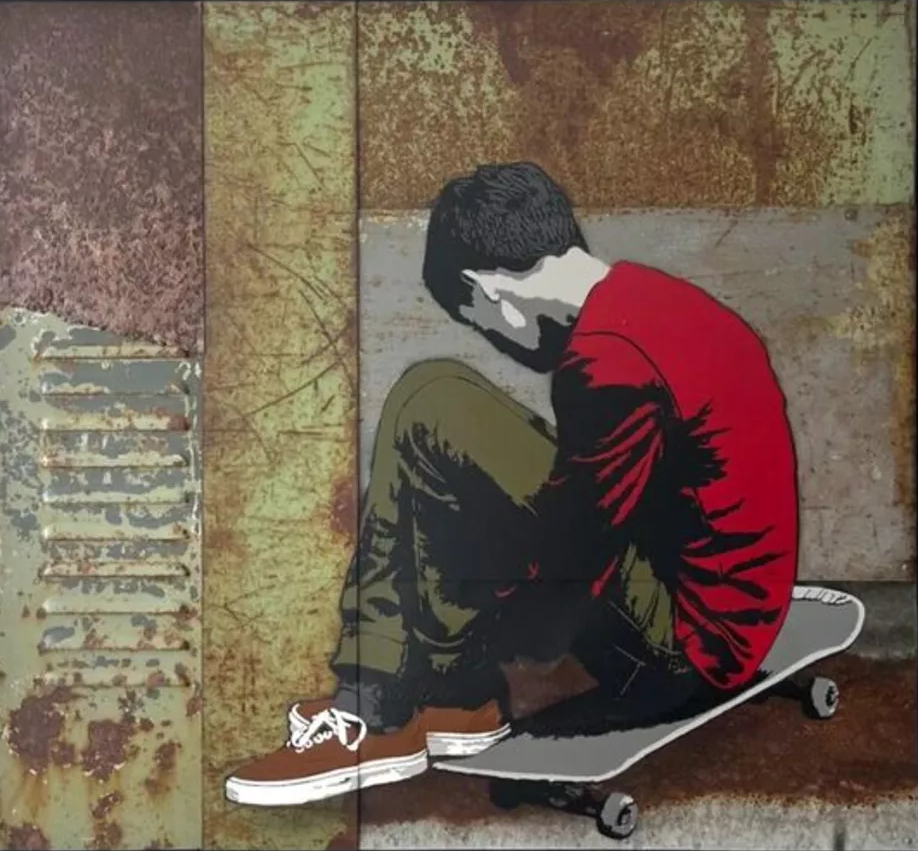Alias, a Berlin-based street artist born in 1980, is widely known for his deeply evocative stencil-based works that explore themes of urban life, alienation, and fleeting human emotions. His art often portrays children, young adults, and marginalized figures in situations that provoke reflection and introspection. Among his most poignant works is Sad Skater (2017), a stencil piece that encapsulates his unique approach to storytelling through street art.
Alias’s Sad Skater is a part of his Fragments series, a collection of artworks that emphasize isolation, memory, and ephemeral moments in the urban landscape. The series, which dates back to 2014, features stencil compositions on paper, canvas, and street walls, each one presenting figures caught in quiet, deeply human experiences. Sad Skater was completed in 2017, measuring 106 x 75 cm, and was later exhibited and sold at Urban Spree Galerie.
This artwork, much like many of Alias’s other pieces, invites viewers to step into the emotional world of its subject. The skater, depicted in a moment of quiet sorrow or contemplation, becomes an emblem of youth, struggle, and the unseen challenges of growing up in an urban environment. Alias, through his minimalist yet evocative approach, captures this emotional depth in a way that is both raw and poetic.
Understanding Sad Skater: Aesthetic and Symbolism
At first glance, Sad Skater appears deceptively as a simple figure in skater attire, sitting with an air of dejection. However, this simplicity is where Alias’s mastery shines. His stenciling technique, typically limited to a monochromatic palette, allows for a stark yet emotionally charged representation. In this piece, the skater’s body language slouched shoulders, downcast gaze, loosely hanging limbs suggests exhaustion, disappointment, or perhaps a deeper existential weariness.
Alias frequently uses children and adolescents as subjects in his artwork, often placing them in urban settings where they appear lost, introspective, or caught in moments of quiet struggle. Sad Skater follows this motif, portraying an individual at the cusp of self-discovery and societal pressure. The skateboard, an object often associated with freedom, rebellion, and youthful energy, takes on a different meaning here. Instead of being in motion gliding along the rough urban pavement it rests idly beside its owner, an extension of the skater’s disheartened state.
The choice to stencil the figure in stark contrast against the background also plays a crucial role. The sharp outlines and monochrome tones create a sense of detachment, emphasizing the solitary nature of the skater. This is a recurring theme in Alias’s work using stenciled figures to highlight the isolation that often exists within bustling city environments. The Sad Skater is not just physically alone but emotionally distant, reflecting the often-overlooked struggles of urban youth.
Alias’s Stencil Art and the Influence of Street Culture
Alias’s artistic journey has been deeply shaped by the underground street art movement in Berlin, a city known for its vibrant graffiti and political stencil work. His works often draw parallels to the likes of Banksy, Blek le Rat, and Jef rosol, all of whom have used stencils to deliver powerful social and emotional narratives.
What sets Alias apart is his ability to distill complex emotions into relatively simple compositions. Unlike more elaborate street murals, Alias’s pieces maintain a raw, almost unfinished quality that aligns with their themes of impermanence and fleeting emotion. The skater in Sad Skater is not heavily detailed, yet every subtle contour of the posture conveys a story one that is open-ended and subject to interpretation.
Skateboarding itself has always been intertwined with street culture, rebellion, and self-expression. In Berlin, as in many major cities, skaters often occupy public spaces that exist on the fringes of societal norms abandoned lots, concrete plazas, and makeshift ramps. The act of skating becomes an assertion of individuality, a way to reclaim urban space. But in Sad Skater, this freedom seems to have momentarily collapsed. The skater, rather than defying gravity and authority, sits weighed down by an unseen burden.
Themes of Alienation and the Fragmented Urban Experience
Alias’s Fragments series, which includes Sad Skater, revolves around the concept of isolation within urban landscapes. Cities, despite their density and constant motion, often create environments where people feel detached and overlooked. This is especially true for young individuals who navigate the pressures of societal expectations, economic hardships, and personal identity crises.
The skater’s loneliness in Sad Skater is emblematic of this broader experience. While the piece does not provide a direct narrative, it suggests multiple interpretations:
A Moment of Defeat: The skater could be resting after an unsuccessful trick, a metaphor for setbacks and failures in youth.
Emotional Fatigue: The posture might reflect a deeper sadness unrelated to skating itself—perhaps struggles with self-worth, relationships, or societal belonging.
A Symbol of Urban Displacement: Skateboarding has often been criminalized in urban spaces, with skaters being pushed out of public areas. The seated figure could represent this displacement, a moment of reflection on belonging and rejection.
By keeping the background minimal and the focus on the individual, Alias ensures that the viewer projects their own emotions onto the skater, making Sad Skater a highly personal and relatable piece.
Street Art as Social Commentary
Alias’s work, though primarily emotional in nature, often carries an undercurrent of social critique. Street art has long been used as a medium for commentary on issues like capitalism, social exclusion, and political unrest. While Sad Skater does not have overt political messaging, it subtly comments on the struggles of modern youth—particularly those who find themselves marginalized in urban environments.
By placing figures like the Sad Skater in cityscapes, Alias highlights the unseen, the forgotten, and the emotionally burdened. His choice to use a stencil technique that itself is a metaphor for repetition and anonymity further reinforces this theme. The skater is one of many, an archetype of urban adolescence that exists across cities worldwide.
Legacy and Reception of Sad Skater
Since its release in 2017, Sad Skater has remained one of Alias’s most recognizable works. It has been exhibited in galleries such as Urban Spree in Berlin, a space known for showcasing street and underground art. The piece, initially sold for, ¬3,500, has likely gained more cultural and artistic value over time, as Alias’s influence in the street art community continues to grow.
Collectors and art enthusiasts appreciate Sad Skater not just for its aesthetic appeal but for its ability to evoke a visceral, emotional response. The universal themes of loneliness, resilience, and youthful introspection make it a compelling work that resonates with diverse audiences.
The Quiet Power of Sad Skater
Alias’s s Sad Skater (2017) is a testament to the power of simplicity in art. Through a single figure, rendered in stark stencil, he captures the weight of urban existence, the struggles of youth, and the fleeting nature of emotion. The work speaks to the universal experience of feeling lost, tired, or momentarily defeated a theme that is as relevant today as it was when the piece was first created.
As street art continues to gain recognition as a legitimate form of artistic and social expression, works like Sad Skater remind us of the raw, unfiltered humanity that exists in public spaces. Alias, through his nuanced stencil technique, offers us a glimpse into these fragmented moments, ensuring that they are not forgotten but rather immortalized in the urban fabric.
No comments yet.








